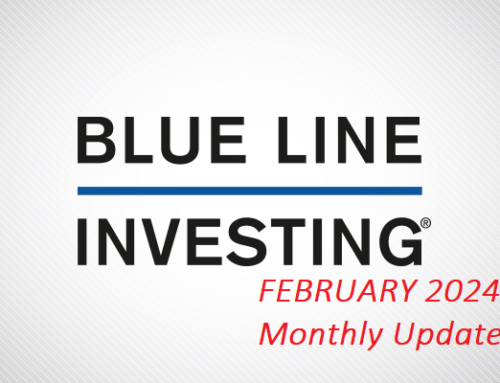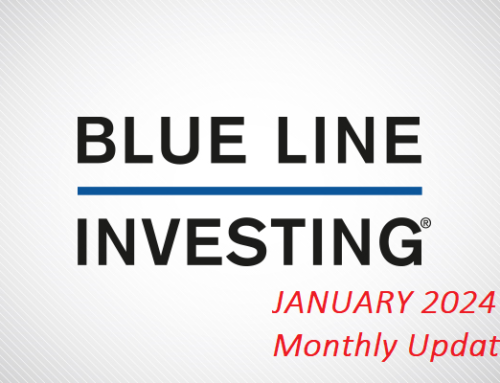The BLI Market View of the S&P 500 Index¹
for the month ending July 2017

Commentary:
The S&P 500 Index (S&P) finished the month of July closing +5.69% above the Blue Line, almost one percent higher from 4.85% at the end of June. According to our process, the S&P would have to decline below the Blue Line to approximately 2,220 for us to proclaim a Phase 1: WARNING of a possible change in trend. For now, we believe the primary trend of the S&P continues to be Positive.
Last month we were monitoring a few indicators that could have been warning of a pending short-term price correction in the stock markets. Those particular warnings have since been negated, but now we are observing something new. While the Dow Jones Industrial Average⁶ has advanced to all-time highs, the Dow Jones Transportation Index⁷ has not. This is called a Dow Theory “non confirmation.” Historically, when the stock market is considered healthy, it is expected that both these indices rise together. When they begin to diverge in price it could be an early warning of a price correction to come. In due time, the Transports may rally to confirm the new high in the Dow, or the non-confirmation may continue. While we typically avoid making investment decisions based on only one potential indicator we will continue to look for any additional witnesses that might provide greater credibility to the current non-confirmation.
Thanks for reading.
Disclaimers:
¹ The S&P 500 Index is one of the most commonly followed equity indices, and many consider it one of the best representations of the U.S. stock market, and a bellwether for the U.S. economy. It is comprised of 500 large companies having common stock listed on the NYSE or NASDAQ. The volatility (beta) of the account may be greater or less than the index. It is not possible to invest directly in this index.
² Blue Line Investing (BLI) is a disciplined investment process, based on technical analysis research. The process applies trend-following, along with observations of the moving averages of the market. Key to the process is the “blue line”, which is derived from comparing an investment’s price against its moving average. BLI monitors those activities over time in order to determine allocations within client accounts.
³ According to Blue Line Investing, once the price of any publicly-traded investment falls below the blue line, the trend is considered “neutral” and could become “negative.” As such, a Phase 1: WARNING, means, by dropping below the blue line, the market is providing a “warning” of distribution.
⁴ According to Blue Line Investing, once the price of any publicly-traded investment fails to rally and remain above the blue line, it is a signal from the market that selling pressure is greater than buying pressure. This results in a Phase 2: FAILURE, representing the markets “failure” to re-establish a trend above the blue line. The probability of a change in trend is higher.
⁵ According to Blue Line Investing, once the price of any publicly-traded investment fails to rally and remain above the blue line on any second rally attempt, this results in a Phase 3: CONFIRMATION – it is “confirmation” from the market that the trend has changed to negative and investors should expect losses for an indeterminate period of time.
⁶ The Dow Jones Industrial Average (DJIA) is a price-weighted average of 30 significant stocks traded on the New York Stock Exchange (NYSE) and the NASDAQ.
⁷ The Dow Jones Transportation Average is a price-weighted average of 20 transportation stocks traded in the United States.
Technical analysis is a method of evaluating securities by analyzing statistics generated by market activity, such as past prices and volumes. Technical analysis attempts to predict a future stock price or direction based on market trends. The assumption is that the market follows discernible patterns and if these patterns can be identified then a prediction can be made. The risk is that markets may not always follow patterns. There are certain limitations to technical analysis research, such as the calculation results being impacted by changes in security price during periods of market volatility. Technical analysis is one of many indicators that may be used to analyze market data for investing purposes and should not be considered a guaranteed prediction of market activity. The opinions expressed are those of Blue Line Investing. The opinions referenced are as of the date of publication and are subject to change without notice. Blue Line Investing reserves the right to modify its current investment strategies based on changing market dynamics or client needs.
Past performance is not indicative of future results. This material is not financial advice or an offer to sell any product. The information contained herein should not be considered a recommendation to purchase or sell any particular security. This information is intended for educational purposes only.
Advisory services offered through Gordon Asset Management, LLC (GAM). GAM is an SEC-registered investment adviser. Registration does not imply a certain level or skill or training. More information about the advisor, its investment strategies and objectives, is included in the firm’s Form ADV Part 2, which can be obtained, at no charge, by calling (866) 216-1920. The principle office of Gordon Asset Management, LLC is located at 1007 Slater Road, Suite 200, Durham, North Carolina, 27703.




